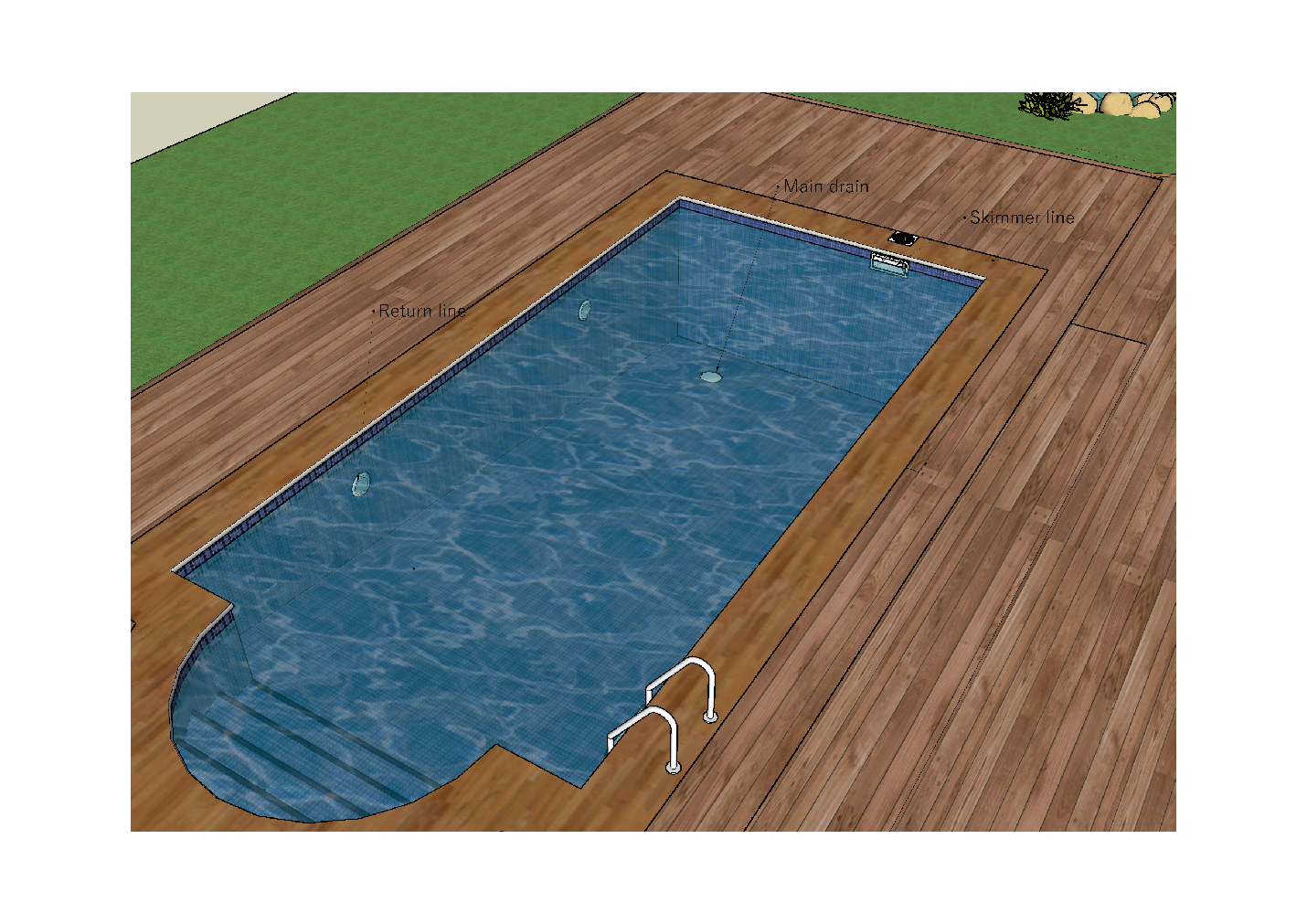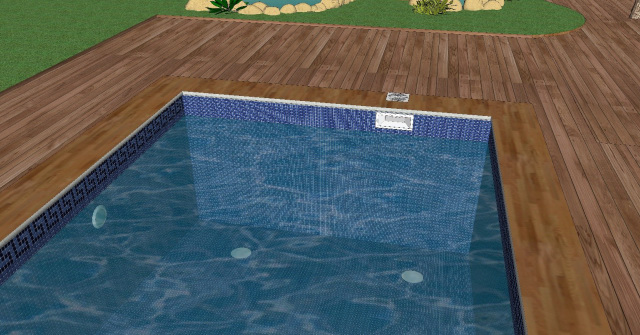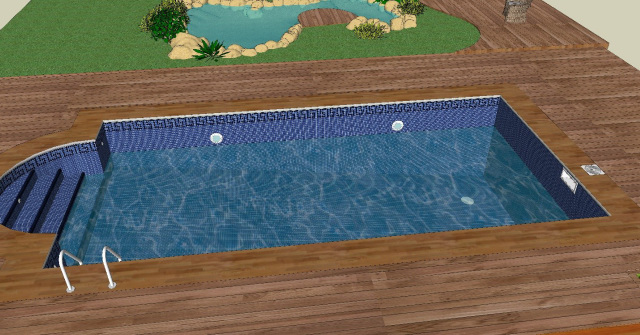As a pool owner, you may find yourself, for one reason or another, at some point wanting to drain your pool. You may want to drain because you are winterizing or closing your pool.
Or perhaps you have some maintenance to perfect. Either way, it can be confusing to know how far to drain your pool and if you should drain it below the skimmer or return jets.
Correctly draining a pool depends on the pool type (fiberglass, concrete or vinyl pools). You can choose to drain a pool partially or completely. Draining partially can be either below the pool skimmer or pool return jets.

Draining a pool can turn out costly if you don’t get it right. Damage may occur to the pool or adjacent properties (your neighbors).
This article highlights where you should drain your pool to and in what situation. We also cover how to drain your pool safely.
Article Contents
Can I Fully Drain the Water In My Pool?
Swimming pools are designed to carry the load (water), and fully draining it may pose a risk. The risk of damage depends on the type of pool you have.
- Fibreglass pools: often less resilient; they have a greater risk of damage from shift and bulging of walls when drained out. The bottom could also pop up.
- Vinyl pools: always recommended to avoid draining at all costs. You can let vacuuming and filtration handle the problem if you want to drain for dirt reasons. Draining could result in the vinyl liner shrinking and losing balance.
- Concrete pools: although tolerant to draining, concrete pools can still face the risk of popping or cracking. To minimize risk, if your pool has hydrostatic relief valves in the bottom or the main drain lines, keep them open.
To avoid these risks altogether, instead of draining your pool in full, partially draining to the skimmer or returns jets may be enough.
Another key consideration is where all that water is going to go. You’ll need to be careful not to let the water run into and flood your neighbors’ property, or your own for that matter.
When Should I Drain My Pool?
There are several reasons you may need to drain your pool. These include:
- Carry out routine pool repair that can’t be done with water in it
- Full refurbishing (resurfacing)
- Pool cleaning (flush out heavy chemical buildup after a long period of pool use)
- Change in climate (partial draining in winter to cover the pool or total drain to prevent evaporation in extremely hot conditions)
- Closing the pool for winter (winterization)
- Water level is too high (above skimmer)
If you are closing your pool, we have a full guide on these processes:
How to Close Above Ground Pool | Easy Way to Winterize
How to Winterize Inground Pool
How Far Should You Drain Your Pool?
Depending on what you want to carry out on the pool prevailing weather conditions, you’ll choose to drain your pool either below the skimmer or below the returns jet.

Can You Drain Below the Skimmer?
Draining below the skimmer is safe for your pool. If you’re draining the skimmer using the pool, stop when the pump runs dry to avoid any damage.
Also known as winterizing level, draining pool below skimmer gives you access to work on your dry skimmer for these two reasons.
- When you want to change renew the skimmer completely
- In preparation for winter. To avoid water entering, freezing and damaging the skimmer (avoid frozen, burst lines during the winter)
What is a Pool Skimmer?
A pool skimmer is a component that captures debris, dirt and other foreign components on the pool surface before they find their way to the pool pump and filtration system. They’re usually built on the side of the pool near the deck. It acts as the first line of defence and forms a critical component of the pools filtration system.
How To Drain Below The Skimmer
You can partially use the pool pump to drain the pool below the skimmer. You can also choose to use a submersible pump on your above ground pool or if your inground pool doesn’t have a main drain.
Drain Using the Pool Pump
- Open the main drain valve and close the valve from the skimmer. (To minimize the risk of the pump sucking air when water levels drop below skimmer).
- Attach a drain hose (backwash hose) to the waste outlet on the pump (or the multiport valve) and then set the multiport valve on the pump to the ‘waste’ setting (or if you have a DE filter, move the valve near the pump to the waste setting).
- Turn on the pool pump and let the water drain a few inches below the skimmer. The pump will run dry. Switch off the pump.
- Once drained, attach a skimmer plate to the skimmer opening to prevent water from entering to prepare for winter.
A similar procedure applies to both in-ground and ground pools when using the pool pump to drain.
Drain Using A Submersible Pump
If your pool doesn’t have a main drain, you can use a submersible pump.
- Turn off the pool pump.
- Attach a drain hose to the outlet port on the submersible pump.
- Lower it into the deep end of the pool.
- Plug the pump into an electrical outlet and begin to drain.
Can The Pool Pump Work When Draining Below The Skimmer?
When water drops below the skimmer, switching on the pool pump with the valve turned to a ‘skimmer’ setting will result in the pump sucking in air and being at risk of burning out the motor on your pool pump causing its damage.
Move the valve so it draws the water from the main drain instead.
Can You Drain Below the Return Jets?
Draining just below the return jets is common practice to winterize or close a pool for the winter season. It is perfectly safe to do this for most pools. Caution should be taken though, if you intend to drain more than 1/3 or ½ of the pool water as this can cause serious damage to the pool.
After the water level reaches the bottom of the skimmer, make sure you set the pool valve to draw the water from the main drain and not the skimmer. This will avoid running the pump dry and potentially burning it out.
Why Drain Below the Return Jets?
Pools are drained below return jets to ensure that no water can get into the pumping system. The pool return jet line is usually roughly 6 inches below the skimmer. Draining below the return jet would mean lowering the water to about 12 inches below the skimmer.
Draining below return jets helps when a pool owner wants to check or winterizes on the underground lines (the return Line running from the top of the filter head to the returning Jet). The owner will unplug and plug the plumbing lines and remove the water from the return lines (or pipes) without water running back into the lines again.
Keeping the pool below return jets helps protect both the skimmer and the return jets from freezing and bursting in winter.
What Is A Pool Return Jet (Eyeball)?

Return jets are also known as eyeballs. If you look carefully on your pool wall, you’ll notice the circular-shaped objects attached to the pool wall (if you use your imagination, they look like eyeballs!).
As the name suggests, pool return jets “return” the newly filtered water back to your pool. Like a freshwater lake with an inlet and outlet, they take the water out of the pool so it can be filtered and return it.
Why Are Pool Return Jets Important?
The jets in your pool play an important job in keep the pool clean.
- Return fresh filtered water from the filtration pump
- Prevent buildup on surfaces
- Distribute pool cleaning chemicals
- Circulate the water are the pool
Whilst we’re on return jets, keep in mind that it’s important to aim and face them the correct way. We have an article on that here:
Where to Aim Return Jets (Eyeballs)
How To Drain Below the Return Jets (Eyeballs)
The procedure for draining below the skimmer and return jets using the pool pump is the same. What varies is how far your drain. To drain below the return jets:
- Open the main drain valve and close the valve from the skimmer. (To minimize the risk of the pump sucking air when water levels drop below skimmer).
- Attach a drain hose to the waste outlet on the pump and then set the valve (near the pump or on the filter) to the ‘waste’ setting to drain out as desired.
- Turn on the pool pump and let the water drain a few inches below the return jets. 6 inches is good. Turn off the pump water is lowered to the level you want.
- If you’re closing the pool for the winter, blow out the lines and place an airtight rubber plug on the jets.
Having gone through the two levels of draining your pool, its good to highlight some important notes to take:
- Correctly set your multiport valve to waste when draining out your pool.
- Shut off the skimmer valve when using the pool pump to drain the pool below the skimmer (this to prevent air suck and running the pump dry).
- Watch out for how much you drain from your pool. It’s not advisable to completely drain your pool.
- Keep the pool skimmer and return jets sealed when the pool is drained for winter.
Related Reading: How to Replace Loose, Cracked, or Broken Pool Tiles

